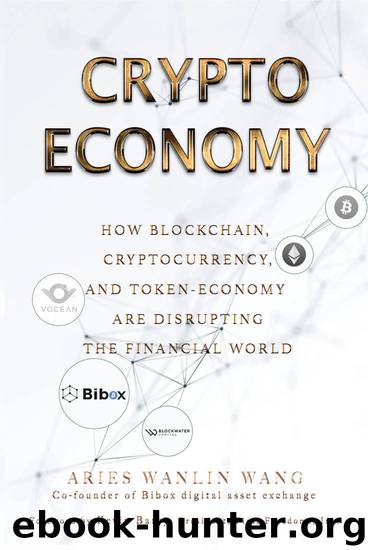Crypto Economy by Aries Wanlin Wang

Author:Aries Wanlin Wang
Language: eng
Format: epub
Publisher: Skyhorse Publishing
Published: 2018-11-08T16:00:00+00:00
6.
THE SECONDARY MARKET: LOW-LYING LAND
In the previous chapters, we’ve covered basic elements of crypto economy—including cryptocurrency, smart contracts, distributed ledger-based DAPPs, ICOs, and tokens. We’ve also explored how crypto exchanges support direct trading between major cryptocurrencies and fiat money, as well as trading among and between different cryptocurrencies. And we’ve reviewed how ICOs have established themselves as a powerful new way of raising capital in crypto world.
Yet all of above is generally happening in what I like to call “the primary market.” And when an ICO is listed in a crypto exchange, it also has to confront investors from the secondary market. The secondary market is kind of similar to the stock market. But because cryptocurrency is still young, when it comes to secondary market influence, we are seeing phenomena that can be quite unusual.
THE SECONDARY MARKET OF LOW LIQUIDITY
There is imbalance between the prime market and secondary market. That’s the first thing to understand. The prime market has become standardized and has been so ever since traditional VC came onto the ICO evaluation scene. Many quality ICOs have been received well in the prime market. However, these same ICOs often get the cold shoulder when they’re listed on the secondary market. There are many reasons for this.
Liquidity reveals how strong a project is in terms of potential cash-out. In a market where there are fewer buyers than sellers, sellers will lower their trading price to attract buyers. In the crypto world, this decreases the value of tokens. The twenty-four-hour trading cycle of the prime market is frenetic and crazy, but the secondary market remains extremely inactive. There are hundreds of tokens being traded in the secondary market, true, but investors do not see any liquidity.
The reason behind this mainly arises from people trying to make quick money in the secondary market. When ICOs reach the secondary market, the prices are much higher than they were in the prime market. Accordingly, shareholders of an ICO often try to cash out before the prices go down in the secondary market. However, prime market investors making fast money and cashing out leaves a mess for the individual investors in the secondary market who have purchased the tokens at the peak of their price. An ICO is like a stock that needs constant buying and selling to maintain its liquidity and value. When early investors in the ICO cash out their shares, it makes it very challenging to maintain stability.
When a blockchain startup launches an ICO, it’s usually still in its early stages. Once it is listed in the market, the startup may find it is not able to keep up with innovations it promised to deliver on paper. What then makes such a situation even worse is when the shareholders try to cash out, which in turn drives the anxiety level of the whole market up. True, some strong projects do continuously improve their service and technology and see their quarterly net profits reliably increasing. However, we cannot assume that this will always, or even typically, be the case.
Download
This site does not store any files on its server. We only index and link to content provided by other sites. Please contact the content providers to delete copyright contents if any and email us, we'll remove relevant links or contents immediately.
The Meaning of the Library by unknow(2385)
Six Billion Shoppers by Porter Erisman(2224)
Why Nations Fail: The Origins of Power, Prosperity, and Poverty by Daron Acemoglu & James Robinson(2170)
No Time to Say Goodbye(1996)
Red Notice by Bill Browder(1924)
The Economist [T6, 22 Thg9 2017] by The Economist(1843)
Currency Trading For Dummies by Brian Dolan(1788)
Thank You for Being Late by Thomas L. Friedman(1675)
Bitcoin: The Ultimate Guide to the World of Bitcoin, Bitcoin Mining, Bitcoin Investing, Blockchain Technology, Cryptocurrency (2nd Edition) by Ikuya Takashima(1611)
Amazon FBA: Amazon FBA Blackbook: Everything You Need To Know to Start Your Amazon Business Empire (Amazon Empire, FBA Mastery) by John Fisher(1493)
Coffee: From Bean to Barista by Robert W. Thurston(1419)
The Future Is Asian by Parag Khanna(1397)
The Great Economists by Linda Yueh(1389)
Capitalism Without Capital: The Rise of the Intangible Economy by Jonathan Haskel(1337)
Pocket World in Figures 2018 by The Economist(1325)
How Money Got Free: Bitcoin and the Fight for the Future of Finance by Brian Patrick Eha(1322)
Grave New World by Stephen D. King(1314)
The Sex Business by Economist(1279)
Cultural Intelligence by David C. Thomas(1201)
